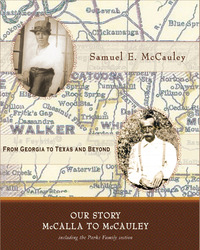Self-Publishing: The Myth of the Local Copy Shop
Biff Barnes
Most people writing family history books and memoirs have a very small audience in mind. They want their children, grandchildren and maybe a few close friends to know something about their origins and life experiences. They see their book not as a commercial project, but as a way to share and preserve their heritage with a group of people they love. They are not experienced authors and know very little about the world of book publishing.
 Stories To Tell client Sam McCauley's family history, published at CreateSpace, and available on Amazon.
Stories To Tell client Sam McCauley's family history, published at CreateSpace, and available on Amazon.
Unfortunately, they hold onto a great myth about getting their story into print. It’s rooted in the experiences of people they may know or have heard about who published a book just a few years ago. The people they heard about went to offset printers – the only kind available at the time – and found they had to purchase a minimum of 250, 500, or even a thousand books. It cost them thousands of dollars and they still have boxes of unread books sitting in their garage. The family historians who want to pass on their stories to their grandchildren may not know much about publishing, but they know they don’t want to have that same awful and expensive experience. They don’t need anything fancy. To economize, they’ll take their book down to the local copy shop, get it printed and coil bound and give copies to their intended audience. They will save a bundle in the process. Unfortunately, that’s just not true.
Let’s assume that our family historian or memoirist has a 250 page book to print. 20 pages will contain color photographs while the rest are text that can be printed in black and white. The book will have a card stock cover printed in color with coil binding.
I called my local Fed Ex Office (although I still call it Kinko’s) for a quote. The voice on the phone took a few seconds to calculate costs and said it would cost $51.20 for a single copy. I said, is there a discount if I order 50 copies? There is. Each copy would cost $34.00. So, if our author who is seeking to economize on his project ordered 50 copies the bill would come to $1,700.
The worst part of the bill is that, our author wound up spending a lot more than he needed to and getting a lot less than he could have. Digital printing has changed the world of publishing in many ways. First, it’s possible to print a single copy of a book for a relatively low price. Second, it’s possible for an author to print a quantity of books at minimal or no upfront cost.
Let’s look at a well-known digital printer, Amazon’s self-publishing subsidiary CreateSpace. (There are plenty of other digital printers including companies like Lulu.) It costs nothing to sign up for a CreateSpace account. Printing a single copy of a 250 page, professional-looking, book store quality, perfect bound paperback in full color costs $18.35. There’s no discount for additional copies. If our author ordered 50 copies to give to readers, it would cost $925, about 54% of the Fed Ex Office price.
Taking things a step further, our author could as part of his CreateSpace account make his book available on Amazon.com. (Many other digital printers have their own on-line bookstores.) It costs the author nothing to do so. He sends the Amazon page link to his intended readers who can order the book and have it shipped directly to them. The author’s total cost for printing the book when he uses this print-on-demand process is $0. The author even gets a small royalty on each sale.
Many authors realize that they need help getting their book ready for publication. They hire an editor or book designer to get their manuscript ready and handle the process of dealing with the print-on-demand publisher they have chosen. They use the royalties they have earned on the sales of their books to defray some of the costs of that professional help.
That’s a lot better than our author will do at the local copy shop.